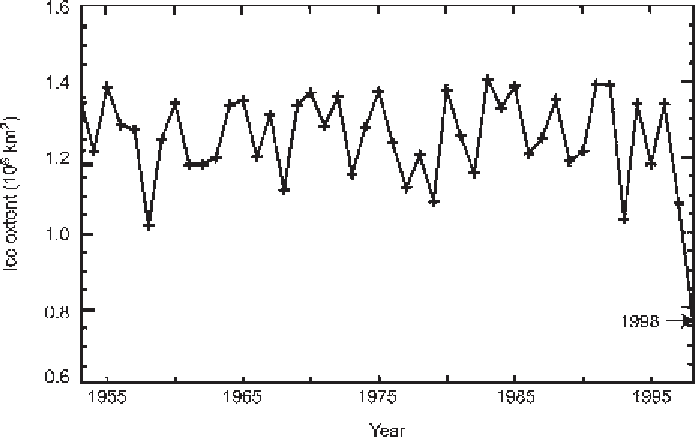Geoscience Reference
In-Depth Information
Figure 7.18.
Sea ice extent at the end of September for the Beaufort Sea region over
the 1953-1998 period (from Maslanik et al.,
1999
, by permission of AGU).
the mean easterly and southerly winds over the Beaufort Sea and favors positive
temperature anomalies, promoting melt and the transport of ice to the west and
north. The sea level pressure and temperature anomalies for the summer of 1997
exemplify the pattern outlined by Rogers (
1978
) for light ice years. The situation in
summer 1998 was somewhat different. Stronger regional pressure gradients favored
stronger ice motion to the west and north. There were also more positive tempera-
ture anomalies over the southern Beaufort Sea as compared to 1997 and other light
ice years. In response to the general westward ice drift, ice concentration and extent
were well above normal in the East Siberian Sea.
The region of open water that developed in the previous summer of 1997 was
replaced the following autumn and winter by primarily thin, first-year ice. First-
Year ice, being relatively thin, will tend to melt out preferentially the next summer.
M. McPhee et al. (
1998
) predicted that because of this preconditioning, a negative
ice anomaly would develop in summer 1998. Although his prediction turned out
to be correct, the atmospheric conditions favoring ice reductions were even better
expressed in 1998 than 1997. The larger size of the 1998 anomaly hence appears
consistent with the dual effects of preconditioning and summer atmospheric forc-
ing. As pointed out by Maslanik et al. (
1999
), the extreme size of the 1998 anom-
aly also requires consideration of other aspects of preconditioning. The November
1997-April 1998 circulation at sea level points to a decrease in northerly winds over
the Canada Basin, reducing the transport of older, thicker ice into the Beaufort Sea
that would normally be supplied by the Beaufort Gyre circulation. This allowed the
large expanse of thin first-year ice to remain in the Beaufort Sea, contributing to the
large ice loss in the summer of 1998.

